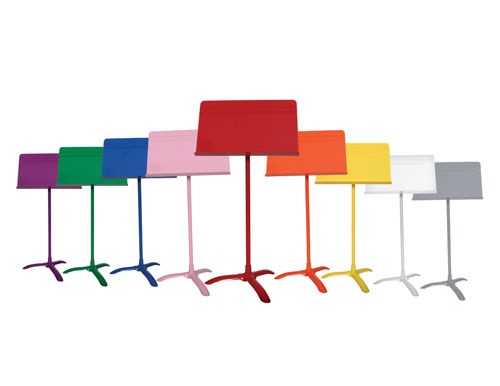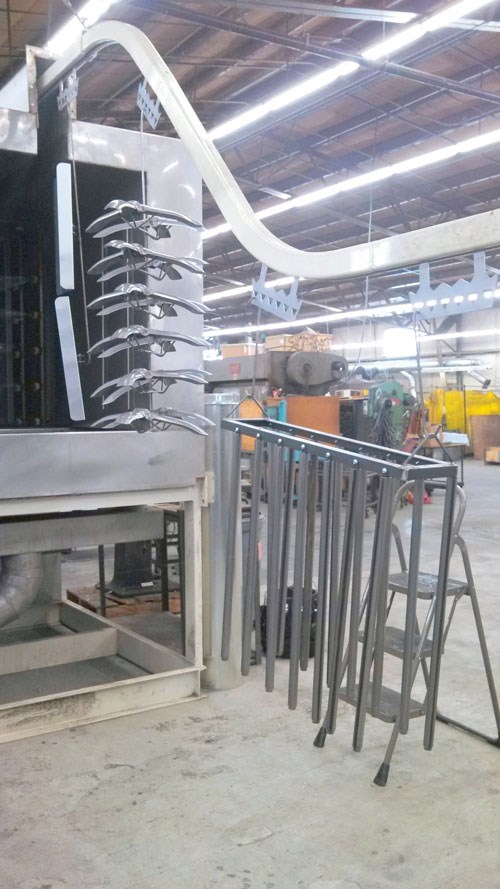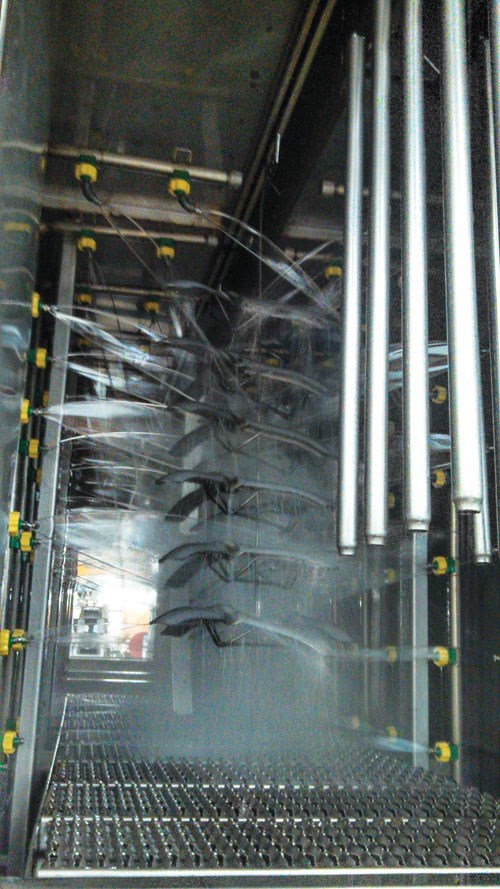Singing The Praise Of A Pretreatment Change
Manhasset Specialty Co. Upgrades Pretreatment Stage of Powder Coating Line
Forget about road salt, chemicals, petroleum or any other corrosive agent when you think about some of the harshest environments a coated product might endure to test its finish.
Try middle and high school band students, many of whom are probably using a music stand made by Manhasset Specialty Company in Yakima, Washington, one of the pioneers in equipment that holds sheet music for everyone from maestros and concert violinists to third-grade school bands.
Inventor and company founder Otto Lagervall developed a better quality music stand back in 1935, one that featured the best materials and workmanship to withstand the rigors of a symphony movement of an elementary school recital. So much so that the company offers a lifetime warranty on the stands, and it’s a good bet that many newly-trained bassoonists and trumpeters have tried to take them up on their offer.
“I have used Manhasset stands since I was a child,” says Douglas Whitaker, director of operations for the Memphis Symphony Orchestra. “I personally prefer Manhasset over competing brands due to weight and bulk. I can pick up three Manhassets in each hand and walk.”
John Demick, stage manager for the Boston Symphony Orchestra, says the Manhasset stands are resilient.
“Simply the best music stand on the market; rugged and durable, yet light for easy movability,” he says. “And Manhasset was kind enough to customize the color to meet our specific needs at Symphony Hall in Boston, which was most appreciated.”

5 Million Stands
There have been more than 5 million Manhasset music stands built in the past 80 years, the first being born when Lagervall—a musician who lived in Manhasset, New York (hence the company name)—became dissatisfied with the shortcomings and workmanship of the music stands he used while playing, and decided to make his own.
During the early 1940s, Lagervall moved the company to Yakima and started mass producing the stands, much to the delight of music teachers and managers of opera houses and symphony halls around the world, who made the Manhasset Specialty Company the No. 1 brand of music stands by the mid-1950s.
“It really is an honor to be known as the company that makes the very best of a certain product,” says Dan Roberts, president and general manager of Manhasset Specialty Co. “We have our products all over the world, and we’re still making several hundred thousand a year. Our customers are very loyal.”
In 2002, Manhasset replaced its paint line with a powder coating system in order to move toward a greener technology. Companies in the Pacific Northwest are well known for their environmental awareness, and Manhasset was no different.
Soon thereafter, the company started to look at its finishing line’s pretreatment system and to ask questions about how it could switch to a greener technology, while still accomplishing the same—or better—quality and adhesion.

The music stands can be powder coated in a variety of colors.
Greener System
With a call to Mary Carpenter at Chemtec North America in Alexandria, Virginia, back in 2007, things started rolling in Manhasset’s search for greener chemical technology, but a series of events stalled the progress of the installation.
The green part of the improvement plan was paramount, but Manhasset’s finishing line personnel had to get their company management on board by showing additional benefits of an upgrade, and the eventual payback it would bring.
Just as the plan was coming together with Chemtec’s help, the process was slowed by the difficult economic times of 2008 and 2009, which put most major improvement project plans on hold. By 2010, the plan was back on the drawing board, and after several years of planning and review, it was finally approved in 2013.
The conventional pretreatment setup Manhasset was using was a typical system that included water and heat to pretreat the surface, with several stages and a single chemistries in each bath. For Manhasset, it was a typical degreaser, rinse, then phosphating followed by another rinse and a sealcoat.
The 5-stage system called for skimming out the oils, as well as changing out the water baths as needed. And it is usually a labor-intensive and expensive proposition, depending on heating costs and water usage.

Chemtec installed its Plaforization system, an organic phosphating technology designed to degrease and phosphate metal surfaces in a one-step operation.
Plaforization
Chemtec was proposing its Plaforization system, an organic phosphating technology that Carpenter says is designed to degrease and phosphate metal surfaces in a one-step operation, all at room temperature, without water and without solid or liquid wastes.
Carpenter, a lawyer by training, has been in the pretreatment industry since 1992 when she and husband Scott met the inventor of one-step metal pretreatment. The relationship grew over time, and they established Carpenter Chemicals to distribute the product in the North American market.
The Plaforization system was designed by PaiKor Chemical (a company that eventually became Chemtec) in Italy in the 1960s. The system operates in a processing cycle that includes a treatment phase of just one minute followed by a several-minute draining phase where excess liquid is recovered, and then a drying phase in which Carpenter says fluid flash-off and organic passivating polymerization take place.
The application can be by sprayed or dipped, but it starts with the oily contaminants being dissolved in the Ecophor chemicals that make up the Plaforization process. The phosphoric acid then reacts with the surface, building a micro chemical bridge in the process. The liquids then evaporate and an organic polymeric film of about 1 micron thick is deposited to create what Carpenter says is a homogeneous and continuous seal on the treated surface
“There is no water pollution, because no water is used in the process,” she says. “There is no solid waste to treat, because no sludge is created.”

The system operates in a processing cycle that includes a one-minute treatment phase followed by a several-minute draining phase where excess liquid is recovered.
No Bath Dumps
More importantly, the treatment bath is never changed if the average amount of oils on the parts does not exceed 14 gm/100 square feet, which is actually more than four times the oil normally found on cold rolled steel. In addition, Carpenter says there are no VOC emissions, HAPs, CFCs, ozone-depleting substances, carcinogens or mutagens.
The Plaforization processes are single-stage with no rinse, and thus have a smaller footprint than typical systems. Carpenter says they are less expensive to operate, have fewer and smaller fans and pumps, and there is nothing spent on natural gas to heat tanks because it is a room-temperature process. In addition, bath checks need to be cond`ucted only every other month.
The process oils on the parts are not skimmed and disposed like a conventional system, Carpenter says, but are used to contribute flexibility to the topcoat.
“The organic microfilm can absorb the oily contaminants into its three-dimensional structure,” she says. “The oils are used as plasticizers, which add flexibility to the film and improves adhesion and chip-resistance. The oils become inert components that actually improve performance.”
Plaforization can work on nearly all metal substrates, she says, including steel, aluminum, stainless steel and magnesium, among others.
“The polymer that is part of the phosphate coating serves two purposes,” Carpenter says. “First, it absorbs oils and greases removed from the part, and by a chemical change these become part of the polymer. When the polymer film is formed, it actually seals the phosphate so that the pretreated parts will resist corrosion for weeks without painting if stored indoors.”

Plaforization can work on nearly all metal substrates, including steel, aluminum, stainless steel and magnesium, among others.
500+ Plants
The Plaforization system is in roughly 500 plants worldwide, and has made a tremendous impact on finishers since it was first introduced to the European market in the late 1960s. The initial release of the system several decades ago was based on chlorinated solvents such as trichloroethylene, methyl chloroform and perchlorethylene. The benefits of these solvents were that they had a quick drying rate, very good degreasing power, and were also non-flammable, which happened to be a big issue in European workplace protection.
At the Manhasset plant, the process for installing the new system took just a few days to get up and running, and the finishing line was using it quickly thereafter. The process met the company’s goal of going to a greener technology—a result was met with applause by those in the Washington region.
The Association of Washington Business, which serves as the state’s Chamber of Commerce and the Manufacturing and Technology Association, gave Manhasset its Green Manufacturing Award in 2014 for its use of the new system, which it says generates zero waste and is more efficient.
The judges for the award evaluated firms’ maximizing energy efficiency levels, going above and beyond regulatory requirements, minimizing waste from the production process and reducing their carbon footprints.
“Our big motivation in this entire project was to be as friendly to the ecology as we could,” Roberts says. “At the same time, we were looking for efficiencies and benefits to our entire operation.”
Roberts says that over the next few months he will evaluate all the cost savings associated with the new Plaforization system, but that he expects there to be a significant improvement overall.
Big Advantages
“We have accomplished a lot of our objectives in so many ways,” he says. “After the wash-off and dry-off ovens were installed, we’ve been able to get our production to where it has been historically.”
The other big benefit that came out of the change was keeping the finishing line up and running without having to stop to change baths and make other adjustments.
“The simplicity of the system has been a big advantage for us,” Roberts says. “You don’t have to dump the chemicals, but rather just add chemicals to the mix, so there isn’t any lengthy delay in the line’s operation.”
And keeping the line going is important as Manhasset sets out to expand its product lines globally, selling to international markets that it hasn’t actively targeted before. That would mean increased production and a higher demand for quality products on a worldwide stage.
“Over the last several years we have started to get quite a bit more business outside of the U.S., so having our production line in good order is very important to us,” Roberts says.
All of which is music to the ears of Manhasset customers all over the world.
Originally published in the September 2015 issue.
Related Content
Top Shop Builds Original Systems for Coating Medical Devices
Engineers at Surgical Coatings in Colorado have been ingeniously developing their own equipment, automation, processes and software since this powder coater’s inception in 1995.
Read MoreHigh Temp Alignment Masking Discs
Designed with printed alignment “target” rings for easy application, PCX-SH Series powder peel green discs from Caplugs ensure pinpoint accuracy when centering over any hole.
Read MorePowder Coater Leverages Its Manufacturing Mindset for Success
As a former motorcycle manufacturer, this powder coating Top Shop benefits from understanding the finishing industry from a customer’s perspective.
Read MoreEPSI Relaunches Custom Masking Program
EPSI’s plotter cutting provides custom solutions for complicated masks and irregular shapes.
Read MoreRead Next
Episode 45: An Interview with Chandler Mancuso, MacDermid Envio Solutions
Chandler Mancuso, technical director with MacDermid Envio discusses updating your wastewater treatment system and implementing materials recycling solutions to increase efficiencies, control costs and reduce environmental impact.
Read MoreA ‘Clean’ Agenda Offers Unique Presentations in Chicago
The 2024 Parts Cleaning Conference, co-located with the International Manufacturing Technology Show, includes presentations by several speakers who are new to the conference and topics that have not been covered in past editions of this event.
Read MoreDelivering Increased Benefits to Greenhouse Films
Baystar's Borstar technology is helping customers deliver better, more reliable production methods to greenhouse agriculture.
Read More










.jpg;maxWidth=300;quality=90)










